–
–
I had a few comments posted in my Leica 35 summarit lens review (see that review here) and 6 e-mails asking me for a comparison against the Zeiss ZM 35 Biogon F2 lens. These two 35mm lenses are considered by many Leica M photographers, but the Zeiss is a bit faster with a maximum F2 aperture and is less expensive! The Zeiss is much like the Leica 35 Summicron (pre-asph) in regards to speed and it sells for about $1000 new. The Leica is a little slower at F2.5 and comes in at about $1700! So is the Leica worth the extra $700? I’ll let you decide.
Since I have both of the lenses here right now and had the requests asking me for a comparison I got the itch to do one. These were quick so no tripod! What these results tell me is that there are color differences between these two lenses more than anything. The Zeiss ZM line has always produced pleasing, warm results. Leica tends to lean on the neutral to cool side.
This is not meant to be a great photo because it is not. Basically, I saw this pink truck with its cracks and rust and thought it would make a good subject for a comparison for color and detail. I pulled up behind it in my car and shot these from my open window. Keep in mind these were both shot at 2.5, ISO 160 with the same shutter speed which was 1/250th of a second. These were converted from DNG using ACR 5.6 with everything set to defaults. In other words, no color tweaks, no sharpening, etc. What you see is what came out of the camera.
First the Leica resized to 1100 pixels wide (click image for 1100 version) – CLICK HERE FOR FULL SIZE FILE
Now the Zeiss, click for 1100 pixel wide version – CLICK HERE FOR FULL SIZE FILE
and now some 100% crops in case you do not have a high speed connection for the full size files:
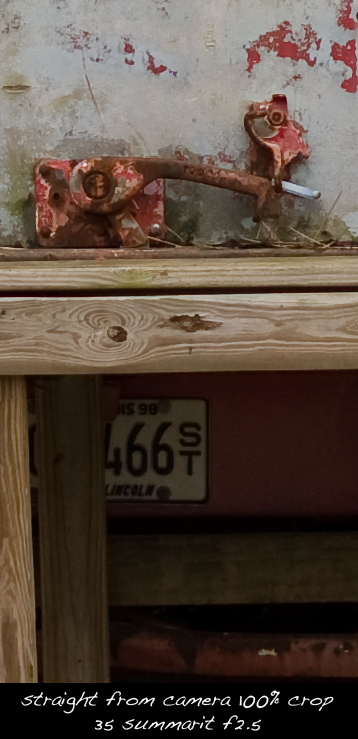
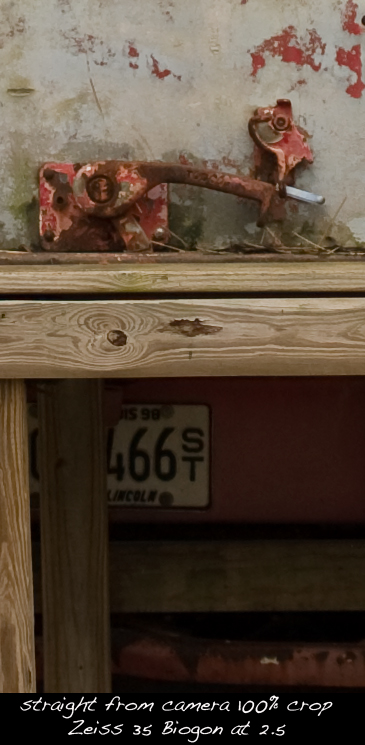
To those who checked out the full files, what do you think? I see the warm/yellowish color cast on the Zeiss, but I see that in ALL Zeiss glass. It’s part of their look. As for detail, the 35 summarit looks to be a little better but the Zeiss is also good. I see vignetting on the Zeiss but did not set up the M9 lens menu with a lens choice.
Here is one more comparison and this time I set up the Zeiss as a pre-asph 35 summicron.
First the Leica 35 Summarit. F2.5, ISO 160, 1/1000th
Now the Zeiss with same settings but the lens set up in the M9 as a 35 Summicron pre-asph.
and the crops. Again, straight RAW conversion with defaults.
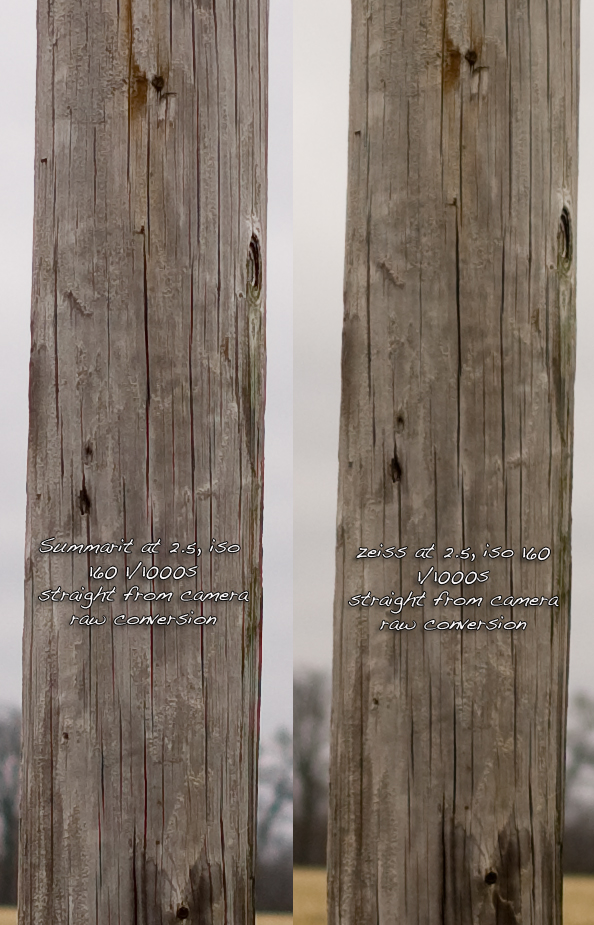
I see the same thing. The 35 Summarit is sharper and more neutral where the Zeiss Biogon is softer and puts out warmer color. But it appears there may be some CA with the Leica crop. Look inside the cracks of the wood. I see some purple 😮 I do not see this in the Zeiss version. Wonder why? Also, you can see the Zeiss was indeed in focus by looking at the crop with sharpening added. This was not added in CS4, but ACR 5.6 during the conversion. Many were trying to say it was OOF but it was not. Remember, the original crops had NO sharpening applied in the RAW conversion.
As for build quality of the two lenses, the Leica seems to be made better. It feels more solid and the focusing is also solid. With the Zeiss I feel a little bit of play in the focus. I also felt that with the Zeiss 50 Planar. But the Zeiss I have here is a loaner and has been around the block a few times, so who knows? Both are good lenses and the Zeiss is close to being half the price of the Leica. It’s a bit softer and produces warmer colors. Also, it can vignette, especially at F2. All of the images here were shot at F2.5 to remain equal with the summarit.
UPDATE: This “quick” comparison has now turned into a not so quick comparison, he he. Anyway, here is one more from both lenses. These had slight sharpening applied this time:
Leica, straight from camera – light was HORRIBLE yesterday…F2.5, ISO 160, 1/500th – Click here for full size file
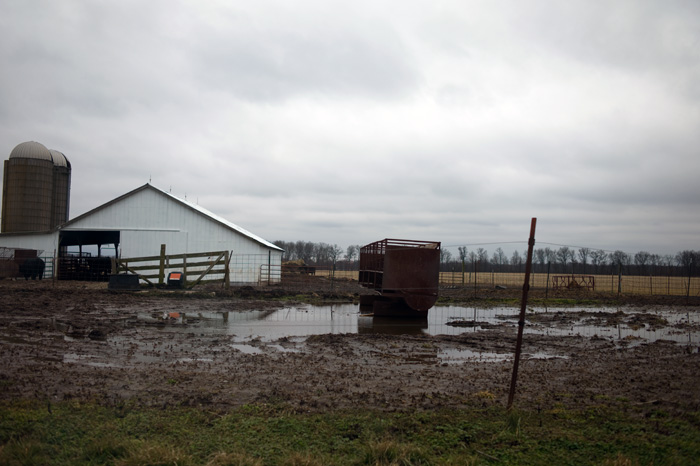
Now the Zeiss, same settings..Click here for original
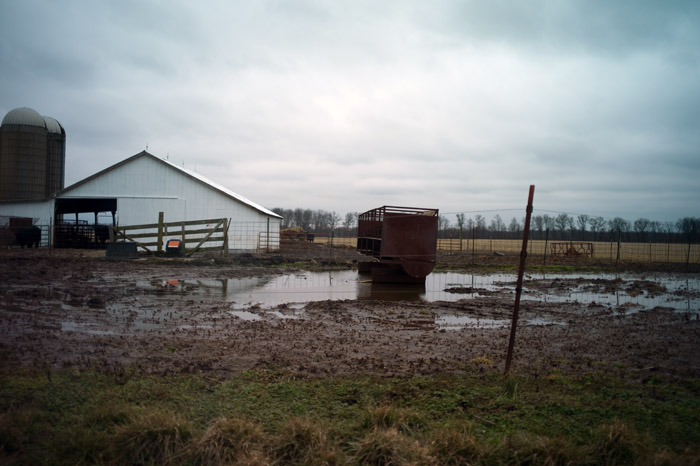
Zeiss ZM Biogon 35 F2 at B&H Photo
Leica 35 Summarit F2.5 at B&H Photo
HELP SUPPORT THIS SITE TO KEEP IT GOING AND GROWING!
Remember, anytime you follow my links here and buy from B&H or AMAZON, this helps to keep my site going. If it was not for these links, there would be no way to fund this site, so I thank you in advance if you visit these links. I thank you more if you make a purchase! I have nifty search bars at the upper right of each page so you easily search for something at either store! I currently spend 14 hours a day working on this site and the only way that I can pay for it is with your help, so thank you!
If you enjoyed this article/review, feel free to leave a comment at the bottom of this page and also be sure to join me on twitteror facebook! Also, you can subscribe to my feed at my subscribe page HERE and read these posts in your browser or news reader! Thanks so much for visiting my site!



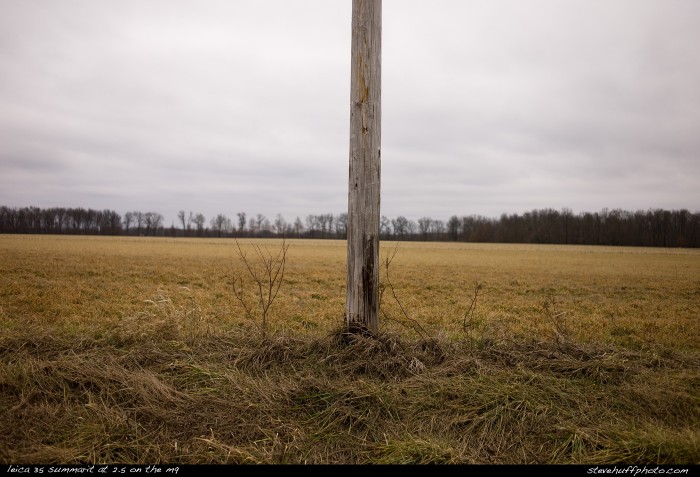
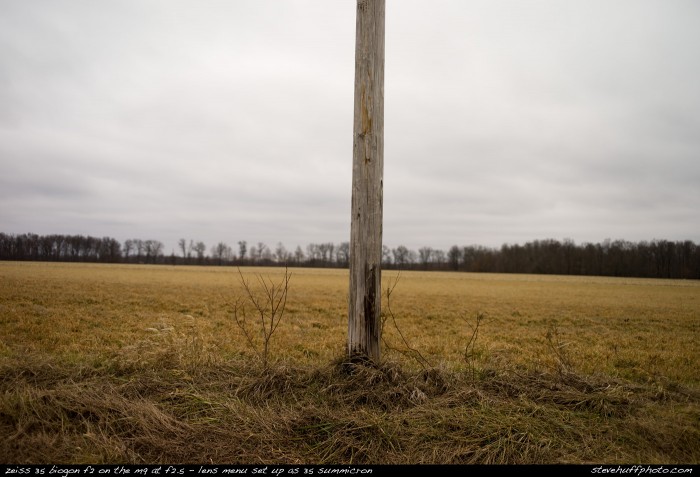
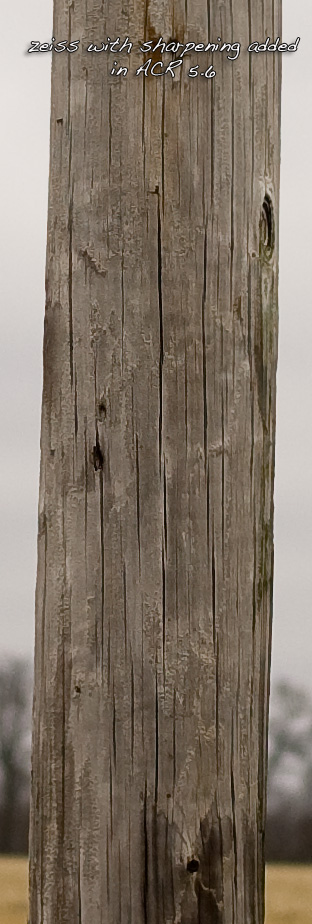

IMO if a layperson off the street that thinks photography is something you do with your phone can tell the difference between two 21st century high caliber lenses in your lens test, the lens test is flawed. Just IMHO. Cheers.
Huh? Does one need to be a cook in order to know if a soup is great or off?
I also find this a little odd. I am using the 35 Biogon on an M9, and find it razor-sharp in the center; not at all like the images above. Both of your reviews and the other I’ve read online find it faring poorly compared with the Leica equivalent, however. Perhaps they do make lemons.
Hi again,
Interesting comparison and in view of the money aspect over here in the UK…..helpful.
And good insight feedback returned. Have viewed all examples closely.
Obs :
1. Get a grip guys, you are talking about mainly MICRO differences here and some of the results are exceedingly close. I suspect all of the criticisms of either lens would simply disappear @ F4. Leaving only the color difference and the like, which is down to personal preference.
Steve, please consider including tests @ F4/5.6 in future, constant repeating tests at wide open is all very well but some of us out here have to satisfy clients with a need of consistent sharpness across the frame. Since i’ve no experience of this kind of hardware, it would be helpful to know. Or is it a case of all is fine per se across the makers @F4 and so little point in reviewing as there would be no difference?
Let me know?
2. The Leica has an advantage that no one seems to have picked up on. Neutrality of color has an advantage. Color PP changes are much easier to deal with from as near as neutral a start point as possible.
Unless the TINY slight and i’d stress slight guys, warmth of Zeiss has a benefit for your portraits.
Steve, the shot of your wife at the restaurant table has exceedingly pale skin tones with the Leica 35mm.
It would be helpful to see how the Zeiss handles skin tones.
I think i’d be happy to own either lens. On a budget it’s a no brainer. Remember, the M9 is the only way to have all of it’s unique particular camera features and if that leaves the wallet short, then the Zeiss does an admirable job.
David
I think Steve’s Biogon is a lemon. I tested mine against the 35mm Cron and the Biogon looked sharper both with M8 and M9. The only hitch with the Biogon is the farthest corner – in my case the upper left the most. I tested the same Biogon against my Ultron and Skopar 35, both of which are quite decent closed to f8. The 35 Cron was superior to the Biogon only until f4
I also own both lenses. My Biogon looks much sharper than the one you tested. I think your Biogon has a problem.
What you say about colour is completely true, the Biogon looks more yellowish.
Interesting comparison. I would like add to things in Zeiss favor.
1. Summarit has terrible chromatic aberration. Zeiss has none (look at the wires, and tree on the left and purple fringing on the pole).
2. Summarit has more profound barrel distortion (look at the pole in full image).
I prefer lens that is less sharp on center, but with no CA i no distortion.
The 2nd set of tests I added today, the Biogon seems to be in focus as the focus point is the sharpest part of the image. I have now shot quite a few frames with both and I get the same result every time. The Zeiss is a little bit softer, it vignettes, has more contrast and warmer color. Still a great lens, just a different look. It’s sharp, but not sharper than the summarit. If you forget to set up the lens in the M9 you get vignetting wide open up to F4.
The Biogon also seems to have smoother bokeh, and also let’s not forget opens up to F2. Still, I prefer the summarit so far but I am still shooting. Ill have some great images from the Biogon in my review. I’m not having focus or softness issues as a little sharpening during the RAW conversion snaps them right up.
Tom, what camera are you shooting the Biogon on? Film, M8 or M9? If not full frame then you are not seeing the edges of your lens, if film then its really hard to tell. On the E-P2 you do not see the vignetting as its all cropped out. Actually, the lens does great on the E-P2.
The Biogon f2 is capable of more than that because I own both the Summarit and the F2 Biogon. In my tests the two come out identical for resolution at F2.4/5 on centre with the Biogon better in the outer field until about f5.6. It is possible that your biogon was a little off in its focus calibration.
The Biogon is higher in contrast, but the Summarit quite a bit smaller and with a gentler signature. I absolutely love the Summarit and it is my everyday go to lens now. It has zero focus shift and just produces beautiful sharp, smooth images no matter what. Speed aside, I can’t fault it and its pretty well welded to a M in my bag.
Steve, could you also post u43 + 20 f/1.7 pls?
Just re-converted the Zeiss “pole” DNG and added some sharpening. It’s in focus, but remember the original crops had NO sharpening applied during the RAW conversion. Thx
Horea, I took this shot 7 times with each lens. All of them are the same. I checked each one and all are the same. The lens focuses fine. As far as “focus bracketing” a lens for testing it on a camera, I personally find that ridiculous. Why? Well, when I am out in the real world shooting am I going to bracket while shooting a street scene? No. A lens is made to be used on a camera to take photographs, not sit in front of a subject bracketing focus trying to get it right.
I do “real world kind of tests and reviews, not scientific. I show how a particular lens or camera performs when using it as its supposed to be used. Using focus bracketing is not how ANYONE shoots their lenses. My M9 is spot on calibrated and every lens I have here is perfect with it. I have shot the 35 Zeiss and it focuses fine. Remember these have ZERO sharpening.
I also took that image with the M4/3 camera and the 20 1.7 at F2.5. That one looks bad next to the Leica and Zeiss. The Zeiss is NOT as sharp as the Leica. You can see that in the truck and the pole. I’ll do another test today. Also keep in mind this lens came direct from Zeiss, so I doubt they would send me a bad copy. I do like the Zeiss though, but the Leica is also built better.
Thanks
Steve
I think therenwas either a problem with the lens or with your focusing. Did you bracket your shots?
Thanks for quick comparison! What I observe is, that ZEISS lens focused closer to the camera, and the cosequence is that:
1) SUMMARIT looks sharper
2) ZEISS background is much more out of focus
Can you see the same? Look on front plan, closer to camera. Don’t you think so?
Isn’t right side of Zeiss photo too dramatically soft? I never saw such Zeiss behaviour. Maybe sth was wrong with this particular lens?
Thanks again!
Thanks for the quick comparisons.You really do a great job.
In the image of the pink truck the Summarit renders the image in a much more pronounced 3D way. The Zeiss is flatter and lacks the luminosity the Leica lens yields. Also in the crop with the license plate, the Summarit is able to capture the gradations of light in the shadow area of the wood or the rusty metal parts. This is a statement to the superiority of the lens in its ability to transmit micro contrasts as well as its better resolving power. The Same applies to the field shot. The Bokeh issue is very subjective and is a matter of personal taste. But the summarits are not clinical lenses and they have some of the Mandler’s feel in their image As a long term investment, and thinking of the future M10 which Erwin Putts hinted subtly will be about 35 Million Pixels (120-140 lpm),It surely makes more sense to invest on a Leica.
Anyway, the Summarits are exceptional designs built in an economic way without compromising Any quality and the Top End Leica S2 line of Lenses are all Summarit designs, which as Peter Karbe States better than some of the best M designs.
While the Summarit appears to be sharper, the background blur of the trees, etc. is quite harsh in some areas compared to the Zeiss. This also caught my attention in some of the images in the Summarit review.
Hmmm…I have the Zeiss 35mm ZM and my copy looks sharper than yours based on your close up crop of the utility pole. Maybe the focusing was a bit off? I love my Zeiss 35mm and 25mm ZM. The Summarits look great too, though – in fact my next lens is likely the 75mm Summarit. Thanks.
The build quality of the Summarit lenses is as good as the modern Leicas. And they all have the same passport warranties to back that up.
Awesome comparison, the summarit really looks good. The only thing holding me back is the fact that the build quality on the summarit lenses should be inferior to the rest of the leica line…
Build quality isn’t the same as on my old 50 Cron or 90 Tele-Elmarit, but its awfully close.